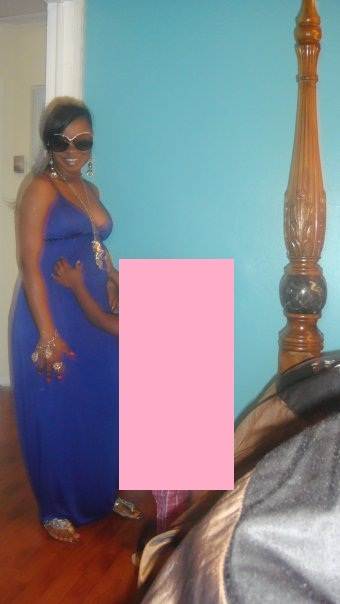MIAMI YEA OR NAY?
Can the metters clear this up for me, Nicky Queen pictured here preggo for Popeye Caution some years back, has had one or two pics of this little girl. Before her pregnancy I could have sworn she was her daughter, however, she eludes questions from her fb friends whether this is her daughter or not. It would be a crying shame if she is because she carry on as if the son she share with Popeye is her only child. Miami folks wheel in fi me deh pls.
Skin Bleach And Civilization: The Racial Formation of Blackness in 1920s Harlem
Skin Bleach And Civilization:
The Racial Formation of Blackness in

1920s Harlem
Jacob S. Dorman, Ph.D.
University of Kansas
Jacob S. Dorman ([email protected]) teaches African American History and American Studies at
the University of Kansas. He has been an NEH fellow at the Newberry Library and a Mellon
fellow at Wesleyan University, Connecticut, among other honors. His first book, to be published
with Oxford University Press, is entitled, Chosen People: African Americans and the Rise of Black
Judaism.
Abstract
Unlike previous scholarship on skin-bleaching advertisements
conducted by scholars such as Lawrence Levine and Kathy
Peiss, this paper finds those advertisements reflected
a definite and widespread preference for light skin among
African Americans in 1920’s Harlem. Newspaper records and historical archives
demonstrate that tangible if permeable boundaries existed between “black,”
“brown,” “light brown,” and “yellow” “Negroes” in 1920’s Harlem. Skin
bleaching was far more than merely cosmetic: it was a profoundly micro-political
form of self-masking and identity shifting mediated by the
new mass market. The advertisements not only appealed to the
desire to be beautiful but also to the desire to find a mate, get a
better job, and associate oneself with the future, modernity, and
progress. Skin bleaching was one practice in a universe of
speech and speech-acts that constituted an African American
version of the discourse of civilization.
At one extreme, skin-bleaching represented part of a “Great
White Hope” that lightskinned “New Negroes” might actually be
able to escape their “Negro” past and become a new near-white
“intermediate” race, as anthropologist Melville Herskovits
pronounced them in 1927. Uncritical reconstructions of a unitary
“black” subject position in 1920’s Harlem obscures the deep divides and antagonisms
based on class and color that striated Harlem society. Recognizing these truths suggests that multiple
“Negro” racial identities were constructed through quotidian actions
both pedestrian and potent.
Keywords: skin bleach, discourse of civilization, racial formation, W.E.B. Du Bois, Marcus Garvey
Introduction: Neither Simple Nor Sanguine
“To absorb a handful of Negroes in America and leave the
unbleached millions of Africa in their savage blackness would be
to deepen the gulf of racial cleavage as a world problem.”1 These
were the words of Kelly Miller, Dean of Howard University, in a
1926 newspaper column entitled: “Is the American
Negro to Remain Black or Become Bleached?” No outraged
letters to the editor followed, nor were Miller’s views out of step
with public opinion in the early decades of the twentieth
century. Miller’s comment illustrates that the practice of skin
bleaching was part of a much larger discourse of civilization, a
discourse that incorporated the uplift of Africa’s “unbleached
millions” and that allowed one of the most prominent African
American commentators of the day to seemingly offensively
entwine the words “unbleached,” “Africa,” “savage,” and
“blackness.” “Bleaching” was a potent double entendre,
referring either to
lightening the skin through bleach or through racial
“amalgamation.” In all senses, bleaching was complicated and
far more than merely cosmetic. Skin bleaching can’t be
understood in simple or sanguine terms, and it repels efforts to
pigeonhole it as either callow self-hatred or bold racial
resistance.2 Rather, the argument of this article is that bleaching
was part of seemingly contradictory ideas of progress, racial
advancement, and civilization.
African American skin bleaching practices in the 1920s
constituted a profoundly micro-political form of self-masking
and identity shifting mediated by both ideology and
consumerism. The mask of face bleach exposes some of the
other
masks that Black folk assumed and fought over in that turbulent
decade, as they struggled among themselves to define the
boundaries and definitions of “the race.” Skin bleaching was
thus a part of an embodied and everyday Black mass discourse
of civilization that illuminates disagreements between titans such
as
W.E.B. Du Bois and Marcus Garvey as well as the alchemy of
racial transformations performed as everyday, private ablutions.
If the formation of African American identity and the racial
formation of Blackness proceeded not as a seamless natural
evolution but through a series of incremental, politicized
discourses, then skin bleaching helps to stain and delineate one
chapter in the racial formation of African Americans.3
Bleaching as a Contested Social Text
The larger context of the cosmetics, hair straighteners, bleaches,
and beauty regimens of the 1920’s was a mass market that
targeted the new generation of young African American women
working in wage labor in cities of the North in the wake of the
Great Migration. Oftentimes created and marketed by African
American women themselves, skin bleaches and hair
straighteners created fortunes worth millions and accounted for a
massive thirty to fifty percent of all advertisements in the Black
press of the decade.4 Containing caustic chemicals such as
hydroquinone, which suppressed the production of melanin in
the skin, skin bleaches could cause severe dermatitis and even
death in high dosages. The power of skin bleaching as a social
text resides partly in the fact that it was part of an intimate,
quotidian, private, and largely un-remarkable ritual, something
hundreds of thousands of people did between washing their
faces and brushing their teeth. Bleaching was a form of self-
fashioning, an autobiographical revision of race performed on
the surface of one’s own body. While lightened skin could
enhance social mobility inside and outside of the Black
community, the practice was also quite literally a form of
disfigurement. James Baldwin wrote of his own twenties Harlem
childhood that popular discourse frequently connected Africa’s
Blackness with her lack of civilization, and attempts to alter
appearance were characterized by shame, rage, pain, and a lack
of positive images of Africa and African Americans:
At the time I was growing up, Negroes in this country were
taught to be ashamed of Africa. They were taught it bluntly, as I
was, for example, by being told that Africa had never
contributed “anything” to civilization…. One was always being
mercilessly scrubbed and polished, as though in the hope that a
stain could thus be washed away…. The women were forever
straightening and curling their hair, and using bleaching creams.
And yet it was clear that none of this effort would release one
from the stigma and danger of being a Negro; this effort merely
increased the shame and rage. There was not, no matter where
one turned, any acceptable image of oneself, no proof of one’s
existence.5
Baldwin’s memory of the connection between Africa’s
blackness, its lack of civilization, and the bitter bodily disciplines
of washing, bleaching, and processing demonstrate that
bleaching helped to stave off what Miller called the “unbleached
millions of Africa in their savage blackness.” The physical and
psychological pain associated with skin bleaching belies attempts
to minimize it or to valorize it as a form of social resistance. The
practice can be better understood in terms of the African
American discourse of civilization and related debates over the
meaning of Blackness.
Scholars working in African American Studies and African
American History have demonstrated how ideologies of race,
gender, uplift, and respectability functioned to shape the Black
public sphere of the early twentieth century.6 All of these
discourses are important constituent parts of what can be
thought of as an African American discourse of civilization. The
concept of civilization encompassed one of the key clusters of
ideas in the Progressive Era, uniting ideas relating to science,
industrialization, consumerism, modernity, race, religion, gender,
evolution and empire, thereby forming a set of received ideas
about what it meant to be civilized. As Matthew Frye Jacobson
writes, the idea of “civilization” in American thought has
historically been “a dense weave of ideas and assumptions
regarding not only proper comportment, manners, social bearing,
and Judeo-Christian belief, but also regarding the fundamental
social issues of property relations, the distribution of wealth,
modes of production, and patterns of consumption.”7 The
African American version of this discourse, which deserves
further explication, sometimes used the dominant discourse in a
recalcitrant manner, as when Ida B. Wells and other
commentators activated its language to accuse white lynch mobs
of being savage, barbaric, and uncivilized.8 The dominant if not
hegemonic discourse of civilization among so-called Negroes in
the late nineteenth and early twentieth centuries connected
Africa to primitiveness and savagery.9 Nevertheless, African
American discourses of civilization of the twenties conceded the
primacy of white constructs of civilization, without conceding
the primacy of whites. Civilizationism, unlike other forms of
white supremacy, offered Blacks a route to greater freedom.
Whereas scientific racism forever confined Black people to
positions of inferiority due to alleged natural qualities, and
Christian racism damned Blacks due to the curse of Ham, the
discourse of civilization at least gave African Americans a
chance to achieve equality by attaining civility.10 As Kelly Miller
wrote in 1905:
A young race, just like the individual, must first appropriate
and apply what has already gone before. The white man has no
exclusive proprietorship in civilization. White man’s civilization
is as much a misnomer as the white man’s multiplication table.
It is the equal inheritance of any one who can appropriate and
apply it.11
Class, color, race, and region all inflected African American
selfpositioning within or against the discourse of civilization and
the practice of skin bleaching. In her study of Black women in
interwar Detroit, Victoria Walcott argues that the self-contained
nature of segregated Black American communities
increased the circularity of values therein, so that the ideology of
respectability was not confined to elites alone.12 A similar
circularity of values adheres in the case of the discourse of
civilization. The desire to be civilized and the desire to
expand and change what it meant to be civilized can be found
across all classes and strata of Black life. Nonetheless, the
signifiers connecting light skin with advanced civilization were
typically densest among the middle and upper class segments of
the Black population.
“The Aristocracy of Color:” Black Colorism
in the 1920s
As early as the middle of the nineteenth century, integrationists
among Black Bostonians emphasized complexion rather than
race, claiming the term “colored” rather than “black” or
“African.”13 Not only did the Black community have “no broadly
accepted new paradigm on race” in the early twentieth century,
as Mia Bay has demonstrated, but the multiple and overlapping
Black communities also debated Blackness itself.14 The debates
continued in the late nineteenth and early twentieth century,
with W.E.B. Du Bois, Booker T. Washington, T. Thomas
Fortune, Alexander Crummell, John Edward Bruce and others
all weighing in on the question of what to call people of African
descent.15
AMEN
Monday, July, 23RD 2012 – A Mombasa bishop said that the gay community poses a far too greater threat than terrorism in Kenya. Bishop Julius Kalu of the Mombasa Anglican Church told his congregation which included Mutava Musyimi, a Presidential aspirant and Gachoka MP that Christians are now challenged by “the enemies of the Church’’ mainly homosexuals and lesbians and terrorism was a lesser threat compared to the first two.
The bishop said, “our greatest fear as a church should not be the grenade attacks, but the new teachings like same sex marriages. Christians should be spiritually armed to confront the challenges.’’
Bishop Kalu was out of the country for about two months during which the debate on gay unions has raged across Coast Province where the practice is prevalent. He was responding to an incident of a grenade attack on Christians in a church in Mombasa and another one in Garissa.
The terror attack in Garissa happened on July 1 where 17 lives were claimed including a Muslim policeman in a hail of bullets on two churches in Garissa. Yesterday, Kalu and Musyimi said Christians are now living in fear after the attacks and are not to attend Sunday service. According to Kalu, terror attacks and crusade for gay unions is a double edged sword pieced through the heart of the church. He added that attendance has dropped in recent times.
“The congregation does not close eyes in prayer for fear of grenade attacks however what the congregation should fear most is new liberal teachings allowing same sex marriages,’’ Bishop Kalu claimed during his sermon at ACK Memorial Cathedral.
He said that the gay movement has eroded moral logic that threatens to cripple the church by introducing unacceptable teachings in the name of freedom of worship and association.
“The church is at war with an enemy of faith and the enemies are those who are changing the Christian doctrine. So Christians must be fully armed and spiritual as it is only divine intervention that will enable the country overcome these challenges,’’ the bishop said.
****RULES**** 1. Debates and rebuttals are allowed but disrespectful curse-outs will prompt immediate BAN 2. Children are never to be discussed in a negative way 3. Personal information eg. workplace, status, home address are never to be posted in comments. 4. All are welcome but please exercise discretion when posting your comments , do not say anything about someone you wouldnt like to be said about you. 5. Do not deliberately LIE on someone here or send in any information based on your own personal vendetta. 6. If your picture was taken from a prio site eg. fimiyaad etc and posted on JMG, you cannot request its removal. 7. If you dont like this forum, please do not whine and wear us out, do yourself the favor of closing the screen- Thanks! . To send in a story send your email to :- [email protected]





Recent Comments